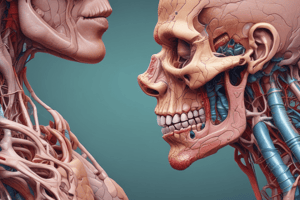Podcast
Questions and Answers
What is the largest salivary gland, and what is the name of its main duct?
What is the largest salivary gland, and what is the name of its main duct?
The parotid is the largest salivary gland, and its main duct is Stensen duct.
What percentage of saliva does the submandibular gland produce, and what is the name of its main duct?
What percentage of saliva does the submandibular gland produce, and what is the name of its main duct?
The submandibular gland produces about 60% of saliva, and its main duct is Wharton duct.
What types of glandular epithelial cells are found in salivary glands?
What types of glandular epithelial cells are found in salivary glands?
The two types of glandular epithelial cells found in salivary glands are serous cells and mucous cells.
What is the shape and characteristics of serous cells?
What is the shape and characteristics of serous cells?
What is the function and characteristics of myoepithelial cells?
What is the function and characteristics of myoepithelial cells?
What is the percentage of saliva produced by the sublingual gland?
What is the percentage of saliva produced by the sublingual gland?
What is the characteristic of the epithelium lining the initial segments of interlobular ducts?
What is the characteristic of the epithelium lining the initial segments of interlobular ducts?
What type of gland is the parotid salivary gland?
What type of gland is the parotid salivary gland?
What is the difference between the submandibular gland and the parotid gland?
What is the difference between the submandibular gland and the parotid gland?
What is the characteristic of the basal nuclei of mucous cells in the submandibular gland?
What is the characteristic of the basal nuclei of mucous cells in the submandibular gland?
What is the characteristic of the sublingual gland?
What is the characteristic of the sublingual gland?
What is the characteristic of the serous cells in the submandibular gland?
What is the characteristic of the serous cells in the submandibular gland?
What is the location of the liver in the human body?
What is the location of the liver in the human body?
What are the two main lobes of the liver?
What are the two main lobes of the liver?
What is the function of the Glisson capsule?
What is the function of the Glisson capsule?
What percentage of the liver is composed of parenchyma?
What percentage of the liver is composed of parenchyma?
What is the function of the interlobular C.T. septa?
What is the function of the interlobular C.T. septa?
What is the shape and size of a classic hepatic lobule?
What is the shape and size of a classic hepatic lobule?
What structures are present in a portal tract?
What structures are present in a portal tract?
What is the central vein in a hepatic lobule surrounded by?
What is the central vein in a hepatic lobule surrounded by?
What is the characteristic of the endothelial cells lining the liver sinusoids?
What is the characteristic of the endothelial cells lining the liver sinusoids?
What is the location of the Disse space?
What is the location of the Disse space?
What is the shape of hepatocytes?
What is the shape of hepatocytes?
How many portal areas are present at the periphery of each hepatic lobule?
How many portal areas are present at the periphery of each hepatic lobule?
What is the typical diameter of most pancreatic islets?
What is the typical diameter of most pancreatic islets?
What types of cells are seen in the islet using immunohistochemical methods?
What types of cells are seen in the islet using immunohistochemical methods?
What hormone is produced by Alpha cells in the pancreatic islets?
What hormone is produced by Alpha cells in the pancreatic islets?
What is the percentage of pancreatic islet cells that are Beta cells?
What is the percentage of pancreatic islet cells that are Beta cells?
What is the function of the fine capsule of reticular fibers surrounding each islet?
What is the function of the fine capsule of reticular fibers surrounding each islet?
What is the arrangement of cells within the islet of Langerhans?
What is the arrangement of cells within the islet of Langerhans?
Flashcards are hidden until you start studying




